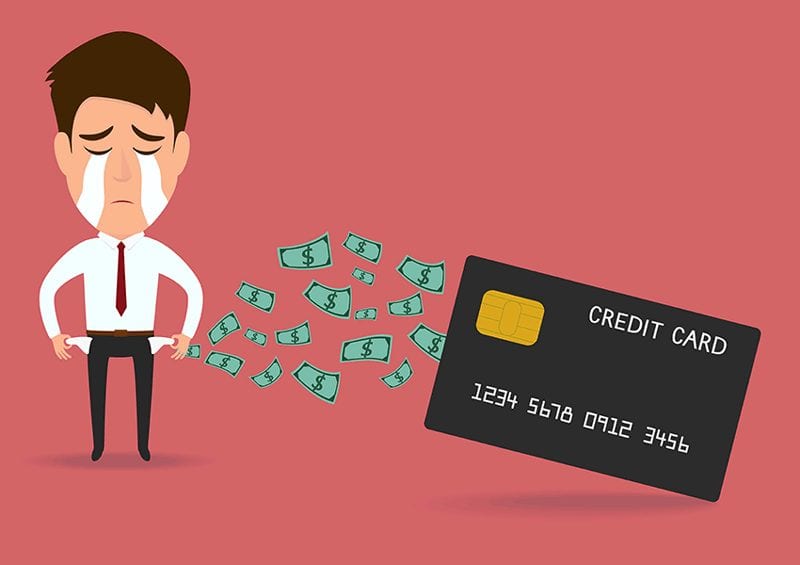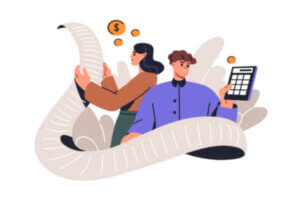Credit card debt can be especially burdensome when the cards carry high interest rates.
Compounding interest can create a snowball effect, making it difficult to pay off the debt and even causing it to grow. With the average credit card interest rate at an all-time high of 22.8%, the challenge is significant. However, it is possible to take steps to manage and reduce your debt.
Paying off high interest credit card debt can be accomplished through a mix of strategies. Among them: ceasing all unnecessary spending, reducing credit card interest rates and consolidating debt are all good steps to take.
What Is High Interest Credit Card Debt?
In general, high interest debt is considered to be anything above an 8% interest rate. The average credit card today carries an interest rate of 22.8%. Using those guidelines, all credit card debt is high interest debt.
How does that stack up historically?
Just a few years ago, the average credit card interest rate was around 16%. That’s much lower than today’s high-rate market, where it’s common to find interest rates around 30%. In early 2024, the Consumer Financial Protection Bureau reported that nine of the largest credit card issuers had at least one card with an annual interest rate higher than 30%. A good interest rate is one that’s below the national average credit card rate, which was 24.35% in August 2025.
When using a credit card, it’s important to understand how credit card debt works. Charging an item on a credit card means the credit card company pays the bill and you agree to repay the credit card company. If the balance is not paid in full by the due date on your bill, interest is charged on the remaining balance, which is when debt can spiral.
As of mid 2024, about half of us carried a credit card balance from month to month. That means we’ve charged a purchase with a credit card, and did not pay the balance due in full.
The interest rates charged on credit cards are high to begin with, and those charges compound daily if the balance is not paid. A large purchase not paid in full can spiral quickly.
How High Interest Credit Card Debt Affects Finances
Interest on credit card debt typically compounds daily and adds up quickly. Growing debt can lead to financial and mental stress, which isn’t good for anyone.
Let’s consider an example with a high interest credit card. Say your water heater fails and you need a new one installed. This can easily cost as much as $3,900. For our purposes let’s say it cost $1,800.
You charge the $1,800, but only pay $100 on the first payment. You now have carried a balance of $1,700, and will be charged the high interest rate of 30%.
If you continue paying $100 a month toward that debt, you won’t be clear of the debt until 25 months later. And by then you’d have paid an extra $621 in interest. The credit card company will be happy, but your wallet will hurt because the initial $1,800 charge for the water heater became $2,421.
This example is not extreme. Many people charge thousands of dollars on credit cards, then find themselves with out-of-control credit card debt – to the point it affects their ability to make ends meet.
Nobody wants to see a good credit score go down or a good credit history tarnished, but credit card debt can have a negative effect on your credit score.
The amount of debt carried on credit card(s) – referred to as credit utilization — is one of the biggest factors in determining a credit score. In general, none of us should exceed 30% of the total allowed credit in borrowing. Those who use $1,000 of $10,000 available on a credit card will have a better credit score than those who charge $9,800 or even max out at $10,000.
The notion of compound interest also makes carrying credit card balances difficult. That’s because when a balance is carried on a credit card, interest is charged on the entire balance, which means on both the principal and any interest accrued. As we showed in our hot water heater example, this compounding of debt will take the total paid well past what was initially borrowed using the credit card.
In addition, credit cards charge interest on the daily balance. So an interest charge is added each day to the debt, which compounds the debt – and which is why it’s called compound interest.
» Learn More: Why Am I Getting Charged Interest on a Zero Balance?
8 Ways to Pay Off High Interest Credit Cards
There are eight main strategies in determining how to pay off a credit card with high interest. These include:
- Stopping unnecessary spending.
- Negotiating a lower interest rate.
- Paying as much of the debt as you can.
- Finding a balance transfer deal at low or no interest.
- Choosing one of the common debt payoff methods
- Taking out a personal loan.
- Making an extra payment each month.
- Pursuing a debt consolidation program.
We’ll take a look at each of these options.
1. Stop All Unnecessary Spending
Stopping spending on items you don’t need – otherwise known as discretionary spending – can be an important first step.
That extra 42” TV that you really don’t need? It can wait. The jewelry that looks nice but will eat into your budget? Wait to buy it. The extra movie channel on the TV? Whittle it down to the one or two you watch. Cook meals as opposed to going to restaurants. Stop smoking. Cut back on expensive coffees. By squeezing extra dollars out of your budget, you might be putting $100 (or more) toward that credit card bill. And that’s a good thing.
Of course pay necessary expenses like the mortgage, food and utilities. Nobody wants their heat or electricity turned off for lack of payment. Spend on necessary expenses, but cut out the discretionary spending and use that money to pay down your debt.
When it comes to spending, it also is wise to consider using cash. This is simple logic. Paying with cash means you are spending what you have, not borrowing against what you don’t have. It will keep you from increasing your debt load and may make spending more reasonable. It’s a lot different to pull a $100 bill out of your wallet than it is to put it on plastic, which can seem like it’s not even spending real money.
2. Ask for a Lower Interest Rate
Creditors will work with their best cardholders, especially if they have a history of paying on time and rarely missing payments. Even credit card companies understand unexpected hardship. If you’re getting offers for other credit card companies with lower rates, don’t be afraid to bargain a bit with your current card company.
While it may seem like an uphill climb to negotiate with a credit card company, it’s not. They want to avoid default, and if a caller is honest and makes sense, they will work with you. One phone call can go a long way, especially if the credit card company feels like it may lose your interest payments.
3. Pay as Much as You Can
If you want to make any dent in the bottom line, you must increase the amount of your monthly payment. If you’re only making minimum payments, much of it goes toward interest and the balance doesn’t move much, if at all.
Study your spending carefully and see what you might be able to apply to credit card debt. If you can find a second part-time job, use that money for the debt, which will help you pay down high interest credit cards. Start with what you can afford, then try to build on that amount.
4. Move to a Balance Transfer Credit Card
This can be one of the better ways to approach credit card debt – provided you qualify.
A balance transfer means paying off the balances on existing cards or loans by transferring them to a new credit card account with a zero-percent interest rate. Generally, you need good-to-excellent credit to be approved, which means a score of 680 or above.
You also might need to compromise. Even if you aren’t approved for the full amount, any little bit helps. It might require a transfer fee — typically 3% of the account — to complete the balance transfer but paying said fee could be worth it in the long run.
By shifting to a 0% deal on a new credit card, you save the 22%-30% interest you were paying.
It is vital to pay close attention to the terms of the new credit card. A zero-interest charge may require complete repayment over 12-18 months. Pay attention when making this kind of decision, and live up to the requirements.
5. Choose a Pay-Off Method: Debt Avalanche or Debt Snowball
Two time-tested methods of paying debt down are always on the table.
A “debt avalanche” means starting with the cards that have the highest interest rate and working your way down to lower interest cards. A “debt snowball’’ means paying off small debts first. Dispensing with a low-balance card debt serves as motivation to attack the high balance cards.
For some, getting rid of high-interest debt isn’t the best strategy, psychologically. It might be better to pay off some smaller balances, thus freeing up money to put toward that high interest rate debt.
Sometimes, the best strategy is to put all your extra money toward a single high interest rate debt. Once that is paid off, work on the next highest debt. Keep going — without using the freed-up money for more purchases — and you’re on the way to debt-free status.
6. If You Can Save Interest, Consider a Personal Loan
A personal loan may be a way to reduce debt, provided the interest rate on the personal loan is less than the interest rate on the credit card.
If you can find a loan for 9% and the credit card is at 24%, you’ve cut your interest charges by more than half. If the best personal loan you can find is 24%, you may be better off simply paying extra on your credit card.
Some lenders may offer special rates in the 4-to-6% range. Any move that gets under the average 22.8% rate is a victory.
7. Try Making Two Payments a Month
An alternative way to reduce the interest paid is to make more than one credit card payment per month. If you can, increase the monthly payment(s) to every card. This will help you pay off the debts faster.
An added benefit of this strategy is that it can strengthen your credit score. You won’t be at risk of missing a payment, and you’ll reduce your credit utilization ratio, which we discussed above.
8. Look Into Credit Card Counseling
Enrolling in credit counseling with a nonprofit counseling agency can help you assess the best strategies to address debt. Nonprofit credit counseling typically is free and involves talking with a certified counselor who assesses the situation and offers solutions that will best address your problem.
A 2016 study from the National Foundation for Credit Counseling found that 73% of those who sought credit counseling paid their debts more consistently, and 70% improved their confidence in their financial situation.
Resources for Paying Off High Interest Credit Cards
InCharge can provide help in several ways for those seeking to reduce credit card debt. Solutions are available, and while some may involve challenges, the long-term gain is worth the short-term pain.
Here’s a look at some of the offerings that may help:
Debt Management. This plan is a carefully constructed schedule, set up by a nonprofit agency like InCharge. The purpose of debt management is to pay off credit card debt by reducing the interest rates and creating a system that allows a regular monthly payment. There is no loan involved and credit scores are not a factor in joining the program. However, those who pursue this option have to close credit cards and make a regular monthly payment until the debt is paid, usually in 3-5 years. In this plan, the payment goes to InCharge and is then distributed to the credit card companies at a lower interest rate.
Debt Consolidation. This approach combines multiple debts into a single payment at a lower interest rate and more affordable payment. Instead of making several payments to different card companies, only one payment is made monthly. Debt consolidation usually means debts are paid off in 3-5 years. Several types of consolidation plans are available, including debt management, personal loans, home equity loans and borrowing from a 401(k). Details and interest for each plan vary, and some may have fees. It’s wise to know and understand the details before proceeding.
Debt Settlement. Debt settlement means negotiating an agreement with a lender to accept less than what you owe. Normally, this is done through a for-profit settlement company, though there are nonprofit debt settlement arrangements as well. The process usually takes 2-3 years and while debt settlement companies often claim they can cut your debt in half, it may not be a magic solution. Many of the claims about debt settlement are misleading and can worsen your situation. In truth, you probably save 25% of your debt. Service fees, interest charges and late fees eat up the rest.
No matter the plan, a good step is to start with counseling through a nonprofit credit counselor. The session is free, and the counselor will attempt to find the best solution for your situation.

11 MINUTE READ
Home » InCharge Blog »
Sources:
- Martinez, D., Seikel, M. (2024, February 22) Credit card interest rate margins at all-time high. Retrieved from https://www.consumerfinance.gov/about-us/blog/credit-card-interest-rate-margins-at-all-time-high/
- White, J. (2019, January 24) Making Multiple Payments Can Help Credit Scores. Retrieved from https://www.experian.com/blogs/ask-experian/making-multiple-payments-each-month-can-help-credit-scores/
- Tong, M. (2024, May 29) How Compound Interest Works With Credit Cards (Everything You Should Know). Retrieved from https://americor.com/blog/glossary/how-compound-interest-works-with-credit-cards/
- NA (ND) 4 strategies to pay off credit card debt faster. Retrieved from https://bettermoneyhabits.bankofamerica.com/en/debt/how-to-pay-off-credit-card-debt-fast
- NA (ND) How to Manage and Pay Off High-Interest Debt. Retrieved from https://www.equifax.com/personal/education/debt-management/articles/-/learn/manage-high-interest-rate/

















